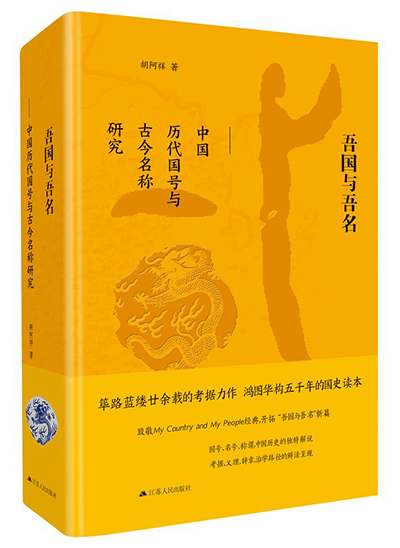Focusing on historical names of China

My Country and Its Names
“Zhongguo,” literally a nation in the world’s center, is usually called “China” in English. It appeared as early as in the Shang and Zhou dynasties (c. 1600–221 BCE), mainly as a regional and cultural concept.
In terms of a regional concept, our ancestors who lived in the Central Plains since ancient times believed that their home was the central place.
As a cultural concept, “Zhongguo” was related to the economic and cultural advancement and superiority of the Central Plains. It was a spiritual symbol that attracted “barbarians” and a link among all ethnic groups in China.
Authored by Hu Axiang, a professor from the School of History at Nanjing University, My Country and Its Names explores the evolution of China’s names in three sections.
The first section of State Titles of Dynasties focuses on the origins of a total of 24 state titles belonging to unified dynasties that ranged from the Xia Dynasty (c. 2100–1600 BCE) to the Qing Dynasty (1644–1911).
This part also analyzes more than 40 state titles established during divided reigning dynasties, such as the Three Kingdoms (220–265), the Southern and Northern Dynasties (420–589), and the Five Dynasties and Ten Kingdoms (907–960).
The second section of Names of China in Ancient and Modern Times elaborates on the various names of China familiar to Chinese people today, such as “Zhongguo,” “Huaxia,” “Zhonghua,” “Jiuzhou” and “Chixian Shenzhou.” This part also pays attention to dozens of lesser-known aliases of China, such as “Quxia,” “Youxia” and “Shixia.”
The last section details the names given to China by other countries and nations, such “Cini,” “Cina,” “Sin,” “China,” “Serice,” “Taugas” and “Cathayc,” and traces how these titles were translated back into Chinese.
“Zhongguo” as a regional concept continued to expand, and as a cultural concept it continued to strengthen. Until the Qing Dynasty, the scope of what historical geographer Tan Qixiang (1911–1992) called “historical China” was formed.
After the establishment of the Republic of China in 1912, “China” as an abbreviation became a concept of a modern political entity. Since the founding of the People’s Republic of China in 1949, “China” as a name has resounded even more on the world stage.
This article was edited and translated from Guangming Daily.
Edited by YANG LANLAN

 PRINT
PRINT CLOSE
CLOSE